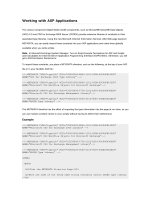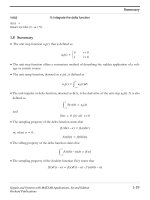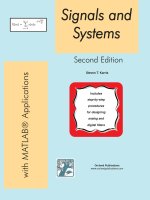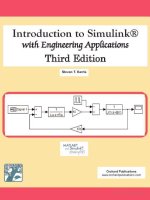Nonlinear optimization with financial applications
Bạn đang xem bản rút gọn của tài liệu. Xem và tải ngay bản đầy đủ của tài liệu tại đây (5.48 MB, 276 trang )
Nonlinear Optimization with
Financial Applications
Nonlinear Optimization with
Financial Applications
Michael Bartholomew-Biggs
University of Hertfordshire
Hatfield, England
KLUWER ACADEMIC PUBLISHERS
Boston / Dordrecht I London
Library of Congress Cataloging-in-Publication Data
A C.I.P. Catalogue record for this book is available
from t h e Library of Congress.
ISBN 1-4020-8110-3 e-ISBN 0-387-24149-3
Printed on acid-free paper.
O 2005 Kluwer Academic Publishers
All rights reserved. This work may not be translated or copied in whole or in part without
the written permission of the publisher (Springer Science+Business Media, Inc., 233 Spring
Street, New York, NY 10013, USA), except for brief excerpts in connection with reviews or
scholarly analysis. Use in connection with any form of information storage and retrieval,
electronic adaptation, computer software, or by similar or dissimilar methodology now
know or hereafter developed is forbidden.
The use in this publication of trade names, trademarks, service marks and similar terms,
even if the are not identified as such, is not to be taken as an expression of opinion as to
whether or not they are subject to proprietary rights.
Printed in the United States of America.
9 8 7 6 5 4 3 2 1
SPIN 11 161363
Contents
List of Figures
List of Tables
Preface
1. PORTFOLIO OPTIMIZATION
1 Nonlinear optimization
2
Portfolio return and risk
3
Optimizing two-asset portfolios
Minimimum risk for three-asset portfolios
4
Two- and three-asset minimum-risk solutions
5
A derivation of the minimum risk problem
6
7
Maximum return problems
2. ONE-VARIABLE OPTIMIZATION
1 Optimality conditions
2
The bisection method
3
The secant method
4
The Newton method
Methods using quadratic or cubic interpolation
5
6
Solving maximum-return problems
3. OPTIMAL PORTFOLIOS WITH N ASSETS
1
Introduction
2
The basic minimum-risk problem
3
Minimum risk for specified return
4
The maximum return problem
xi
...
Xlll
4. UNCONSTRAINED OPTIMIZATION IN N VARIABLES
1
Optimality conditions
2
Visualising problems in several variables
3
Direct search methods
4
Optimization software & examples
5. THE STEEPEST DESCENT METHOD
1 Introduction
2
Line searches
3
Convergence of the steepest descent method
4
Numerical results with steepest descent
5
Wolfe's convergence theorem
6
Further results with steepest descent
6. THE NEWTON METHOD
1 Quadratic models and the Newton step
2
3
4
5
Positive definiteness and Cholesky factors
Advantages & drawbacks of Newton's method
Search directions from indefinite Hessians
Numerical results with the Newton method
7. QUASI-NEWTON METHODS
1 Approximate second derivative information
2
Rank-two updates for the inverse Hessian
3
Convergence of quasi-Newton methods
4
Numerical results with quastNewton methods
The rank-one update for the inverse Hessian
5
6
Updating estimates of the Hessian
8. CONJUGATE GRADIENT METHODS
1
Conjugate gradients and quadratic functions
2
3
4
5
Conjugate gradients and general functions
Convergence of conjugate gradient methods
Numerical results with conjugate gradients
The truncated Newton method
Contents
9.
OPTIMAL POR!I'FOLIOS WITH
RESTRICTIONS
1 Introduction
2
Transformations to exclude short-selling
Results from Minrisk2u and Maxret2u
3
Upper and lower limits on invested fractions
4
10. LARGER-SCALE PORTFOLIOS
1
Introduction
2
Portfolios with increasing numbers of assets
3
Time-variation of optimal portfolios
4
Performance of optimized portfolios
11. DATA-FITTING & THE GAUSSNEWTON METHOD
1 Data fitting problems
2
The Gauss-Newton method
Least-squares in time series analysis
3
4
Gauss-Newton applied to time series
5 Least-squares forms of minimum-risk problems
Gauss-Newton applied to Minriskl & Minrisk2
6
12. EQUALITY CONSTRAINED OPTIMIZATION
1 Portfolio problems with equality constraints
2
Optimality conditions
3
A worked example
4
Interpretation of Lagrange multipliers
5
Some example problems
13. LINEAR EQUALITY CONSTRAINTS
1
Equality constrained quadratic programming
2
Solving minimum-risk problems as EQPs
3
Reduced-gradient methods
4
Projected gradient methods
Results with methods for linear constraints
5
14. PENALTY FUNCTION METHODS
1 Introduction
2
Penalty functions
vii
...
Vlll
3
4
5
The Augmented Lagrangian
Results with P-SUMT and AL-SUMT
Exact penalty functions
15. SEQUENTIAL QUADRATIC PROGRAMMING
1 Introduction
2
Quadratic/linear models
3
SQP methods based on penalty functions
4
Results with AL-SQP
5
SQP line searches and the Maratos effect
16. FURTHER PORTFOLIO PROBLEMS
1 Including transaction costs
2
A rebalancing problem
3
A sensitivity problem
17. INEQUALITY CONSTRAINED OPTIMIZATION
1 Portfolio problems with inequality constraints
2
Optimality conditions
3
Transforming inequalities to equalities
4
Transforming inequalities to simple bounds
5
Example problems
18. EXTENDING EQUALITY-CONSTRAINT METHODS
1 Inequality constrained quadratic programming
2
Reduced gradients for inequality constraints
3
Penalty functions for inequality constraints
4
AL-SUMT for inequality constraints
5
SQP for inequality constraints
6
Results with P-SUMT, AL-SUMT and AL-SQP
19. BARRIER FUNCTION METHODS
1 Introduction
2
Barrier functions
3
Numerical results with B-SUMT
20. INTERIOR POINT METHODS
1 Introduction
2
Approximate solutions of problem B-NLP
Contents
3
4
An interior point algorithm
Numerical results with IPM
21. DATA FITTING USING INEQUALITY CONSTRAINTS
1
Minimax approximation
Trend channels for time series data
2
22. PORTFOLIO REBALANCING AND OTHER PROBLEMS
Rebalancing allowing for transaction costs
1
2
Downside risk
3
Worst-case analysis
23. GLOBAL UNCONSTRAINED OPTIMIZATION
1
Introduction
2
Multi-start methods
3
DIRECT
4
Numerical examples
Global optimization in portfolio selection
5
Appendix
References
Index
List of Figures
Convex contours of (3.4.1)
Nonconvex contours of (3.4.1)
Multiple stationary points of (3.4.1)
Wolfe conditions on a quadratic function
Wolfe conditions on a non-quadratic function
Wolfe conditions on a non-convex non-quadratic function
Solutions to problem T9 varying with time
Solutions to problem TI0 varying with time
Mean returns from optimum portfolio for problem T9
Mean returns from optimum portfolio for problem T10
Least-squares trend line for share prices (1 1.4.1)
Least-squares model (1 1.4.3) for share prices (1 1.4.1)
Least-squares model (1 1.4.4) for share prices (1 1.4.1)
An illustration of a filter
Typical share price data for 65 days
Trend lines for share price data in figure 21.1
Trend channel (days 1 to 20) for data in Figure 2 1.1
Trend channel (days 20 to 40) for data in Figure 21.1
Trend channel (days 40 to 60) for data in Figure 2 1.1
Contours of (23.1.1)
One iteration of DIRECT on a one-variable problem
Two iterations of DIRECT on a one-variable problem
43
44
44
60
60
61
111
112
114
114
123
124
125
178
229
229
231
231
232
243
245
246
List of Tables
Monthly rates of return on three assets
Daily rates of return on three assets
Monthly rates of return on two assets
Solution of MinriskO for first two assets in Table 1.2
Solutions of Risk-Retl for first two assets in Table 1.2
Solutions of Minrisklm for first two assets in Table 1.2
Solutions of Minriskl for assets in Table 1.1
Rates of return on four assets
Solutions of Maxretlm for assets in Table 1.3
Solutions of Maxretlm for first two assets in Table 1.2
Rates of return on four assets
Rates of return on five assets over ten periods
SDp solutions for problems TI - T4
Ultimate convergence of SDp on problems T I - T4
Performance of SDp and SDw on problems TI - T4
Performance of NMp and NMw on problems T1 - T4
Ultimate convergence of SDw and NMw on problem T4
Performance of QNpand QNw on problems T I - T4
Ultimate convergence of NM and QN on problem T4
Performance of CGp and CGw on problems T1 - T4
Ultimate convergence of QN and CG on problem T4
Solutions from 'm' and 'u' forms of Minriskl and Maxretl 99
Solutions for problems T5 and T5a
102
Comparing NM , QN and CG on problems T l a and T2a
102
Solutions for problems T6 and T6a
103
Comparing NM, QN and CG on problems T3a and T4a
Performance of NM, QN and CG on problem T7(n)
Performance of NM, QN and CG on problem T8(n)
Risk levels at solutions to problem T9
Portfolio returns at solutions to problem T I 0
Comparing GN, NM and QN on Problems T1 and T5
Comparing GN, NM and QN on problems T l a and T5a
Iteration counts for SOLVER with linear constraints
Iteration counts for SOLVER with non-linear constraints
P-SUMT and AL-SUMT solutions to problem T4
P-SUMT solutions to problem T4 for varying rl
Total QN iterations/function calls for P-SUMT and AL-SUMT
AL-SQP solution to problem T4 with rl = 0.1
Performance of AL-SQP on problems T11-T14
Performance of SUMT and SQP on problems T7 and T8
Problem T9 with different transaction costs
Problem T9 with different transaction costs on asset 2
Rebalancing problem T9 with different values of V,
Iteration counts for SOLVER on problems T 1 1a-T 12b
Iteration counts for SOLVER on problems T13a-T14b
Perfromace of SUMT and SQP on problems T l 1a-T14a
Performace of SUMT and SQP on problems T l 1b-T14b
B-SUMT and P-SUMT solutions to problem T l l b
B-SUMT and P-SUMT solutions to problem T13b
Perfromance of SUMT and SQP on problems T l lb-T14b
IPM solution to problem T13b
Performance of IPM and AL-SQP on problems T 1 1b-T 14b
Preface
This book has grown out of undergraduate and postgraduate lecture courses
given at the University of Hertfordshire and the University of Bergamo. Its primary focus is on numerical methods for nonlinear optimization. Such methods
can be applied to many practical problems in science, engineering and management: but, to provide a coherent secondary theme, the applications considered
here are all drawn from financial mathematics. (This puts the book in good
company since many classical texts in mathematics also dealt with commercial arithmetic.) In particular, the examples and case studies are concerned
with portfolio selection and with time-series problems such as fitting trendlines and trend-channels to market data.
The content is intended to be suitable for final-year undergraduate students
in mathematics (or other subjects with a high mathematical or computational
content) and exercises are provided at the end of most sections. However the
book should also be useful for postgraduate students and for other researchers
and practitioners who need a foundation for work involving development or
application of optimization algorithms. It is assumed that readers have an understanding of the algebra of matrices and vectors and of the Taylor and Mean
Value Theorems in several variables. Prior experience of using computational
methods for problems such as solving systems of linear equations is also desirable, as is familiarity with iterative algorithms (e.g., Newton's method for
nonlinear equations in one variable).
The approach adopted in this book is a blend of the practical and theoretical. A
description and derivation is given for most of the currently popular methods
for continuous nonlinear optimization. For each method, important convergence results are outlined (and we provide proofs when it seems instructive to
xvi
do so). This theoretical material is complemented by numerical illustrations
which give a flavour of how the methods perform in practice.
It is not always obvious where to draw the line between general descriptions
of algorithms and the more subtle and detailed considerations relating to research issues. The particular themes and emphases in this book have grown
out of the author's experience at the Numerical Optimization Centre (NOC).
This was established in 1968 at the Hatfield College of Technology (predecessor of the University of Hertfordshire) as a centre for research in optimization
techniques. Since its foundation, the NOC has been engaged in algorithm development and consultancy work (mostly in the aerospace industry). The NOC
staff has included, at various times, Laurence Dixon, Ed Hersom, Joanna Gomulka, Sean McKeown and Zohair Maany who have all made contributions
to the state-of-the-art in fields as diverse as quasi-Newton methods, sequential
quadratic programming, nonlinear least-squares, global optimization, optimal
control and automatic differentiation.
The computational results quoted in this book have been obtained using a
Fortran90 module called SAMPO.This is based on the NOC's OPTIMA library
- a suite of subroutines for different types of minimization problem. The
name SAMPO serves as an acronym for Software And Methods for Portfolio
Optimization. (However, it is also worth mentioning that The Sampo appears
in Finnish mythology as a magical machine which grinds out endless supplies
of corn, salt and gold. Its relevance to a book about financial mathematics
needs no further comment.) The SAMPO software is not described in detail in
this book (which does not deal with any programming issues). Interested readers can obtain it from an f t p site as specified in the appendix. Some of the
student exercises can be attempted using SAMPO but most of them can also be
tackled in other ways. For instance, the SOLVER tool in Microsoft Excel can
handle both constrained and unconstrained optimization problems. Alternatively, users of MATLAB, can access a comprehensive toolbox of optimization
procedures. The NAG libraries in C and Fortran include a wide range of minimization routines and the NEOS facility at the Argonne National Laboratories
allows users to submit optimization problems via email.
I am indebted to a number of people for help in the writing of this book
Besides the NOC colleagues already mentioned, I would like to thank Alan
Davies and all the staff in the Mathematics Department at the University of
Hertfordshire for their support. I am particularly grateful to Don Busolini and
Steve Kane, for introducing me to the financial applications in this book, and
to Steve Parkhurst for sharing the lecture courses which underpin it. I have
received encouragement and advice from Marida Bertocchi of the Universty of
Bergamo, Alistair Forbes of the National Physical Laboratory, Berc Rustem of
PREFACE
xvii
Imperial College and Ming Zuo of the University of Alberta. Useful comments
and criticisms have also been made by students who were the guinea-pigs for
early versions of the text. Surrounded by such clouds of witnesses, any mistakes or omissions that remain in the text are entirely my responsibility.
My thanks are also due to John Martindale and Angela Quilici-Burke at Kluwer
Academic Publishing for their encouragement and help with the preparation of
the final version of the book.
Most of all, my deepest thanks go to my wife Nancy Mattson who put up
with the hours I spent incommunicado and crouched over my laptop! Nancy
does not share my attachment to computational mathematics: but she and I do
have a common commitment to poetry. Therefore, scattered through the book,
the reader will find a number of short mathematically-flavoured poems which
occupy pages that would otherwise have been mere white space. To those
who have asked how mathematical aptitude interacts with poetic composition
a reply could be
Two cultures
Poets show, don't tell:
build metaphors from concrete
and specific bricks.
In mathematics
the abstract and general's
our bread and butter.
For more on this subject, the reader may wish to consult [66,67,68].
Chapter 1
PORTFOLIO OPTIMIZATION
1.
Nonlinear optimization
Optimization involves finding minimum (or maximum) values of functions.
Practical applications include calculating a spacecraft launch trajectory to maximize payload in orbit or planning distribution schedules to minimize transportation costs or delivery times. In such cases we seek values for certain
optimization variables to obtain the optimum value for an objective function
We now give a simple example of the formulation of an optimization problem.
Suppose we have a sum of money M to split between three managed investment
funds which claim to offer percentage rates of return rl, r;! and r3. If we invest
amounts y l , y:! and yg we can expect our overall return to be
If the management charge associated with the i-th fund is calculated as ciyi,
then the total cost of malung the investment is
Suppose we are aiming for a return Rp% and that we want to pay the least
charges to achieve this. Then we need to find yl , y2 and y3 to solve the problem
Minimize
c l y l + c2y2
+ cgy3
(1.1.1)
This is an optimization problem involving both equality and inequality constraints to restrict the values of the variables. The inequalities are included
because investments must obviously be positive. If we tried to solve the problem without these restrictions then an optimization algorithm would attempt to
reduce costs by making one or more of the yi large and negative.
In fact, since they only involve linear expressions, (1.1.1) - (1.1.3) represents a
Linear Programming problem. However, we do not wish to limit ourselves to
linear programming (which is a substantial body of study in its own right - see,
for instance, [I] - and involves a number of specialised methods not covered
in this book). Instead, we shall be concerned with the more general problem in
which the function andlor the constraints are nonlinear.
The simple investment decision considered above could be represented as a
nonlinear programming problem if we imagined that an attempt to make a
negative investment would be penalised by a very high management charge!
Thus we could consider the problem
subject to
r l y l + r2y2
+ r3y3 = M R p
and yl +y2 +y3 = M
(1 . I S )
where K is a large positive constant and the function y~ is defined by
The objective function (1.1.4) is now nonlinear (being linear for some values of
the yi and quadratic for others) and it features two linear equality constraints.
Equality constraints can sometimes be used to eliminate variables from an optimization problem. Thus, since y3 = M - yl - y2, we can transform (1.1.4),
(1.1.5) into the problem of minimizing the two-variable function
subject to the single constraint
Obviously (see Exercise 1 below) we could go further and use the equality
constraint (1.1.7) to express yl in terms of y2. Our problem could then be
expressed as an unconstrained minimization of a f~lnctionof a single variable.
3
Portfolio optimization
In the chapters which follow we shall describe several methods for solving
nonlinear optimzation problems, with and without constraints. Applications
of these methods will be taken from the field of portfolio optimization, using
ideas due to Markowitz [2, 31 which are introduced in the next section.
Exercises
1. Reformulate (1.1.6), (1.1.7) to give an unconstrained minimization problem
involving yl only.
2. Using the values M = 1000,Rp = 1.25,K = low3together with
cl = 0.01, c2 = 0.009, c3 = 0.014 and r l = 1.2, r2 = 1.1, r3 = 1.4
plot a graph of the function obtained in question 1 in the range 0 5 yi 5 M.
Hence deduce the minimum-cost that produces a return of 1.25%.
How does the solution change in the cases where c3 = 0.012 and c3 = 0.01 l ?
3. Formulate the problem of finding the maximum return that can be obtained
for a fixed management cost Cr. (Note that the problem of maximizing a function F ( x ) is equivalent to the problem of minimizing -F (x).)
2.
Portfolio return and risk
Suppose we have a history of percentage returns, over m time periods, for each
of a group of n assets (such as shares, bonds etc.). We can use this information
as a guide to future investments. As an example, consider the following data
for three assets over six months.
Assct 1
Asset 2
Asset 3
January
1.2
1.3
0.9
Return % for
February March April
1.3
1.4
1.5
1.0
0.8
0.9
1.1
1.0
1.1
May
1.1
1.4
1.1
June
1.2
1.3
1.3
Table 1.1. Monthly rates of return on three assets
In general, we can calculate the mean return Yi for each asset as
where ri,i (i = 1, ..,n, j = 1, ..,m) denotes the return on asset i in period j.
Hence, for the data in Table 1.1 we get
If we spread an investment across the n assets and if yi denotes the fraction invested in asset i then the values of the yi define aportjolio. Since all investment
must be split between the n assets, the invested fractions must satisfy
The expected portfolio return is given by
Thus, for the data in Table 1.1, we might choose to put half our investment
in asset 1, one-third in asset 2 and one-sixth in asset 3. This would give an
expected return
The risk associated with a particular portfolio is determined from variances
and covariances that can be calculated from the history of returns rij. The
variance of asset i is
C:=l (rij - ~ i ) ~
0; =
m
while the covariance of assets i and k is
Evaluating (1.2.4), (1.2.5) for the returns in Table 1.1 we get
0: = 0.0181; 0;
= 0.0514; 0; = 0.0147;
(1.2.6)
The variance of the portfolio defined by the investment fractions y l , ...,y,, is
which can be used as a measure of portfolio risk. Thus for a three asset problem
Portfolio optimization
Using (1.2.6) and (1.2.7), the risk function V for the data in Table 1.1 is
Thus, for a portfolio defined by yl = &,y2 = T1 , y3 =
1
1
1
-0.00388 x - 0.01056 x 12
18
which gives a risk V z 0.00153.
+
The return and risk functions (1.2.3) and (1.2.8) can be written more conveniently using matrix-vector notation. Expression (1.2.3) is equivalent to
where 7 denotes the column vector (71,72, ...,7,) and y is the column vector
of invested fractions (yl ,y2, ...,yn)T.Moreover, we can express (1.2.8) as
where the variance-covariance matrix Q is defined by
In (1.2.12) we have used the equivalent notation
Thus, for data in Table 1.1,
We can also write (1.2.2) in vector form as
S = e Ty = 1
where e denotes the n-vector (1,1, ..,
Exercises
1. Returns on assets such as shares can be obtained from day-to-day stock
market prices. If the closing prices of a share over five days trading are
calculate the corresponding returns using the formula
Pi - Piri = 100
Pi- 1
What returns are given by the alternative formula
Pi
ri = 1001og,(-)?
pi- 1
Show that the two formulae for ri give similar results when [Pi- Pi-1 1 is small.
2. Calculate the mean returns and the variance-covariance matrix for the asset
data in Table 1.2.
Asset 1
Asset 2
Asset 3
Table 1.2.
3.
Day 1
0.15
0.04
0.11
Return % for
Day 2 Day 3
0.26
0.18
-0.07
-0.05
0.21
0.06
Day 4
0.04
0.07
-0.06
Day 5
0.06
0.03
0.12
Daily rates of return on three assets
Optimizing two-asset portfolios
We begin by considering simple portfolios involving only two assets. There
are several ways to define an optimal choice for the invested fractions yl and
y2 and each of them leads to a one-variable minimization problem. The ideas
introduced in this section can be extended to the more realistic case when there
are n (> 2) assets.
The basic minimum risk problem
A major concern in portfolio selection is the minimization of risk. In its simplest form, this means finding invested fractions yl ,...,y, to solve the problem
MinriskO
I2
Minimize V = y
T ~ J 1
subject to
yi = 1.
i= l
(1.3.1)
Portfolio optimization
Like the earlier example (1.1.4), (1.1.5), this is an equality constrained minimization problem for which a number of solution methods will be given in
later chapters. Our first approach involves using the constraint to eliminate y,
and yield an unconstrained minimization problem involving only yl ,...,y,- 1.
In the particular case of a two-asset problem, we wish to minimize V = y T ~ y
with the constraint yl + y2 = 1. If we write x in place of the unknown fraction
yi then y2 = 1 - yl = 1 - x. We can now define
+ px so that problem MinriskO becomes
Minimize
(1.3.3)
V = (a+ px) ~ (+ px)
a .
and then it follows that y = a
Expanding the matrix-vector product we get
V = aT~a
+ (2pTQa)x + (pTep)x2.
At a minimum, the first derivative of V is zero. Now
dx
= 2pTQ a
+ 2pTQ&
and so there is a stationary point at
This stationary point will be a minimum (see chapter 2) if the second derivative
and we shall be able to show later on that this cannot be negative.
We now consider a numerical example based on the following Table 1.3.
Asset 1
Asset 2
January
1.2
1.3
Return % for
February March April
1.3
1.4
1.5
1.0
0.8
0.9
May
1.1
1.4
June
1.2
1.3
Table 1.3. Monthly rates of return on two assets
These are, in fact, simply the returns for the first two assets in Table 1.1 and
so ? is given by (1.2.1) and the elements of Q come from (1.2.6) and (1.2.7).
Specifically we have
1.2833
i = ( 1.1167 a n d
0.0181
a = ( -0.0281
-0.0281
0.0514
)
(1.3.6)
'
If we use Q from (1.3.6) then ( 1.3.3) becomes
V = 0.05 14-0.1590x+0.1256~.
Hence, by (1.3.4) and (1.3.5),
dV
dx
- = -0.159
-
0.159
+O.2512x and so x = 0.25 12 0'633'
Since V has a positive second derivative,
we know that a minimum of V has been found. Hence the minimum-risk portfolio for the assets in Table 1.3 has yl = x % 0.633. Obviously the invested
fraction y2 = 1 - yl z 0.367 and so the "least risky" strategy is to invest about
63% of the capital in asset 1 and 37% in asset 2. The portfolio risk is then
V z 0.001 12 and, using the ? values in (1.3.6), the expected portfolio return is
Exercise
Find the minimum-risk portfolio involving the first two assets in Table 1.2.
Optimizing return and risk
The solution to problem MinriskO can sometimes be useful; but in practice we
will normally be interested in both risk and return rather than risk on its own.
In a rather general way we can say that an optimal portfolio is one which gives
"biggest return at lowest r i s k . One way of trying to determine such a portfolio
is to consider a composite function such as
The first term is the negative of the expected return and the second term is a
multiple of the risk. If we choose invested fractions yi to minimize F then we
can expect to obtain a large value for return coupled with a small value for risk.
The positive constant p controls the balance between return and risk.
Portfolio optimization
Based on the preceding discussion, we now consider the problem
Risk-Retl
n
Minimize
F = -rTY+p y T ~ y subject to
Cyi= 1.
(I .3.8)
i= 1
As in the previous section, we can use the equality constraint to eliminate Y , ~
and then find the unconstrained minimum of F, considered as a function of
y1,. ..,yn-p In particular, for the two-asset case, we can we write x in place
of the unknown yl and define a and P by (1.3.2) so that y = a + px. Problem
Risk-Retl then becomes
Minimize F =
-(
F ~ ~ ) px [+a T ~ 2(pTQa)x+
a+
(pTQp)x2]. (1-3.9)
Differentiating, we get
and so a stationary point of F occurs at
We now consider the data in Table 1.3. As before, values for T; and Q are given
by (1.3.6) and so F becomes
In order to minimize F we solve
This gives
and this stationary point is a minimum because the second derivative of F is
0.25 12p which is positive whenever p > 0.
For p = 5, (1.3.1 1) gives yl = x = 0.765. This implies y2 = 0.235 and the
portfolio expected return is about 1.244% with risk V FZ 0.00333. If we choose
p = 10 (thus placing more emphasis on reducing risk) the optimal portfolio is
y1 = 0.7, y2 = 0.3 giving R FZ 1.233% and V
= 0.00167.
Exercises
I . Solve (1.3.9) using data for assets 2 and 3 in Table 1.2 and taking p = 100.
2. Based on the data in Table 1.3, determine the range of values of p for which
the solution of (1.3.9) gives x lying between 0 and 1. What, in general, is the
range for p which ensures that (1.3.10) gives 0 5 x l ?
<
Minimum risk for specified return
Problem Risk-Retl allows us to balance risk and return according to the choice
of the parameter p. Another approach could be to fix a target value for return,
say R,%, and to consider the problem
Minriskl
(1.3.12)
Minimize V = yTQy
z
1
fiyi = R,, and
yi = 1.
i= 1
i= 1
One way to tackle Minriskl is to consider the modijied problem
subject to
(1.3.13)
Minrisklm
P
+ -(L
fiyi
R; j=1
I1
"
Minimize F = yTQY
-
R , , ) ~ subject to
yi = 1. (1.3.14)
i= 1
At a minimum of F we can expect the risk yTQy to be small and also that the
return F~~ will be close to the target figure R,,. As in Risk-Retl, the value of
the parameter p will determine the balance between return and risk.
For the two-asset case we can solve Minrisklm by eliminating ya and using
the transformation y = a px where x = yl . We then get the problem
+
Minimize F = ( a + p x ) ' ~ ( a + P x ) + P~ ( -7'r a - R , + ~ ~ b ) ~ (1.3.151
.
RP
After some simplification, and writing
p in place of p / ~ g F, becomes
T 2 2
aT~a+p(rTa-~,,)2+2(~T~a+p(rTa-~,)~TP)x+(pT~P+p(?
P) )x .
A minimum of F occurs when its first derivative is zero, i.e. at
For the assets in Table 1.3, values of r and Q are given in (1.3.6) and so









